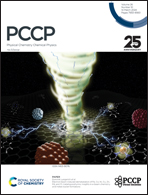Contrasting the stability, octahedral distortions, and optoelectronic properties of 3D MABX3 and 2D (BA)2(MA)B2X7 (B = Ge, Sn, Pb; X = Cl, Br, I) perovskites†
Abstract
Efficient surface passivation and toxic lead (Pb) are known obstacles to the photovoltaic application of perovskite-based solar cells. A possible solution for these problems is to use thin-films of two-dimensional (2D) perovskite-based materials and the replacement of Pb with alternative divalent cations (B); however, our atomistic understanding of the differences between (3D) three-dimensional and 2D perovskite-based materials is far from satisfactory. Herein, we report a systematic theoretical investigation based on ab initio density functional theory (DFT) calculations for both 3D MABX3 and the Ruddlesden–Popper 2D (BA)2(MA)B2X7 (B = Ge, Sn, Pb, and X = Cl, Br, I) compounds to investigate the differences (contrasts) in selected physical–chemical properties, i.e., structural parameters, energetic stability, electronic, and optical properties. We found an increased cation/anion charge separation because of the presence of organic spacers, which results in stronger Coulomb interactions in the inorganic framework, and hence, it enhances the cohesive energy (stability) within the inorganic layer. The inorganic layer constitutes the optically active region that contributes to the superior performance of perovskite-based solar cells. We quantified this effect by comparing the average electronic charges at the X sites in both 2D and 3D perovskites. This comparison is then correlated with variations in BX6-octahedron volumes, resulting in a monotonic relation. Moreover, the electronic structure characterization demonstrates that Ge-based systems present weakly sensitive band gaps to dimensionality due to a compensatory effect between Jahn–Teller distortions and quantum confinement. Lead-free GeI-, SnBr-, and SnI-based perovskites have DFT band gaps closer to the optimal value used in photovoltaic applications. Finally, as expected, the 2D systems absorption coefficients show pronounced anisotropy.



 Please wait while we load your content...
Please wait while we load your content...